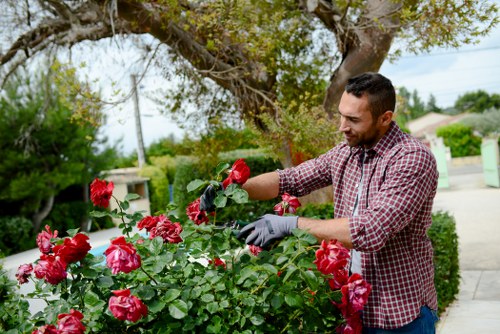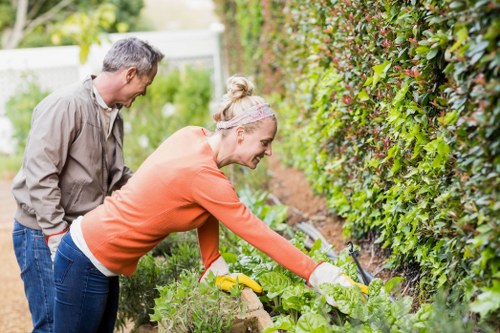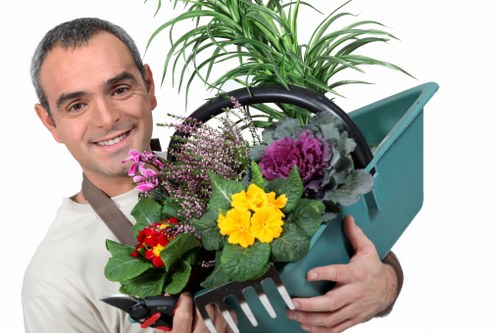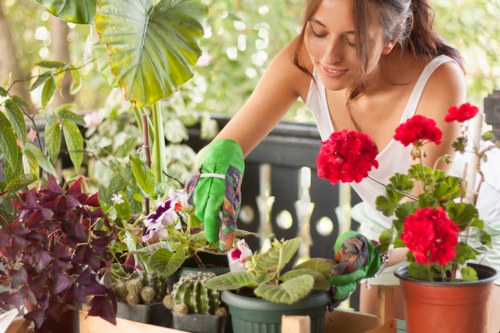Ultimate Guide to Garden Maintenance in Rosebud

Introduction to Garden Maintenance
Maintaining a beautiful garden requires dedication, knowledge, and the right tools. In Rosebud, garden enthusiasts take pride in their lush landscapes and vibrant floral displays. Whether you're a seasoned gardener or just starting, understanding the essentials of garden maintenance in Rosebud can transform your outdoor space into a picturesque retreat.
Rosebud's climate offers unique opportunities for a wide variety of plants to thrive. However, it also presents challenges such as seasonal changes and local pests that can affect your garden's health. Implementing effective garden maintenance practices ensures that your plants remain healthy and your garden stays attractive throughout the year.
In this comprehensive guide, we'll explore the best practices for garden maintenance in Rosebud, from soil preparation and planting to pest control and seasonal upkeep. Our goal is to provide you with the knowledge and tools needed to create and maintain a stunning garden that enhances your home's beauty.

Essential Garden Maintenance Tips
Soil Preparation and Fertilization
Healthy soil is the foundation of a thriving garden. In Rosebud, the soil composition can vary, so it's essential to test your soil's pH and nutrient levels before planting. Adding organic matter, such as compost or well-rotted manure, can improve soil structure and fertility.
Fertilization plays a crucial role in providing plants with the necessary nutrients. Depending on the type of plants you're cultivating, you may need to apply specific fertilizers to promote growth and flowering. Regularly amending the soil ensures that your garden receives a steady supply of essential nutrients.
Proper soil preparation not only supports plant health but also enhances water retention and drainage, preventing issues like root rot and nutrient leaching. Taking the time to prepare your soil will yield long-term benefits for your garden's vibrancy and resilience.

Irrigation and Water Management
Efficient irrigation is vital for maintaining a healthy garden, especially during Rosebud's hot summers. Installing a drip irrigation system can help conserve water by delivering it directly to the plant roots, reducing evaporation and runoff. This method ensures that your plants receive the right amount of moisture without wasting resources.
Mulching around your plants can also aid in water retention by keeping the soil cool and reducing surface evaporation. Organic mulches, such as bark or straw, add nutrients to the soil as they break down, further benefiting your garden.
Monitoring your garden's moisture levels and adjusting your watering schedule based on weather conditions will help maintain optimal soil moisture. Consistent watering practices support robust plant growth and minimize the risk of drought stress.

Pest and Disease Management
Identifying Common Pests in Rosebud
Pests can pose a significant threat to your garden's health. In Rosebud, common pests include aphids, caterpillars, and beetles, which can damage plants by feeding on leaves, stems, and roots. Regularly inspecting your plants for signs of infestation is crucial for early detection and control.
Using natural remedies, such as introducing beneficial insects like ladybugs and lacewings, can help manage pest populations without harmful chemicals. Neem oil and insecticidal soaps are effective organic options for controlling pests while maintaining a safe environment for beneficial organisms.
Implementing integrated pest management (IPM) strategies, which combine biological, cultural, and mechanical control methods, promotes a balanced ecosystem in your garden. This approach minimizes the reliance on chemical pesticides and fosters long-term pest resistance.

Preventing and Treating Plant Diseases
Plant diseases can devastate your garden if not addressed promptly. Common diseases in Rosebud gardens include powdery mildew, root rot, and blight. Maintaining proper air circulation, avoiding overhead watering, and removing diseased plant parts are essential preventive measures.
Using disease-resistant plant varieties can also reduce the risk of infection. Regularly rotating plants and practicing good sanitation, such as cleaning garden tools and removing debris, helps prevent the spread of pathogens.
If a disease takes hold, applying appropriate fungicides or organic treatments can help control the outbreak. Early intervention is key to minimizing damage and preserving the health of your garden.

Pruning and Trimming Techniques
Importance of Regular Pruning
Pruning is an essential aspect of garden maintenance that promotes healthy growth and enhances the appearance of your plants. Regular pruning helps shape plants, remove dead or diseased branches, and encourage the development of strong, vigorous growth.
In Rosebud, various plants require specific pruning techniques. For example, fruit trees benefit from pruning to improve fruit production and air circulation, while flowering shrubs benefit from trimming to maintain their shape and encourage blooming.
Proper pruning tools and techniques ensure that you make clean cuts, reducing the risk of infection and promoting quick healing. Investing time in learning the correct pruning methods will yield significant benefits for your garden's overall health.

Seasonal Pruning Guidelines
Different seasons call for different pruning activities. In the spring, focus on removing any winter damage and shaping new growth. Summer pruning helps manage the size and shape of plants, promoting better airflow and light penetration.
Autumn pruning prepares your garden for the colder months by removing spent flowers and trimming back overgrown branches. This practice helps prevent disease and pest infestations during the winter.
Winter pruning should be minimal, focusing primarily on removing any remaining dead or diseased wood. By following seasonal pruning guidelines, you ensure that your garden remains healthy and well-maintained year-round.

Weed Control Strategies
Preventing Weed Growth
Weeds can quickly overtake your garden, competing with your plants for nutrients, water, and sunlight. Preventing weed growth starts with proper garden planning and maintenance. Using landscape fabric or laying down a thick layer of mulch can suppress weed emergence by blocking sunlight and creating a barrier.
Regularly inspecting your garden and removing weeds before they set seed is crucial for long-term control. Hand-pulling or using tools like hoes and weeders can effectively manage weed populations without harming your desirable plants.
Cultivating dense plantings reduces the available space for weeds to grow, creating a competitive environment that naturally limits weed spread. Combining these methods ensures a weed-free garden that allows your plants to flourish.

Natural and Chemical Weed Control
While manual weed removal is effective, there are also natural and chemical options for weed control. Organic herbicides, such as vinegar-based solutions, can be used to target specific weeds without harming the surrounding plants. These treatments are environmentally friendly and safe for use around children and pets.
Chemical herbicides offer a more extensive solution for stubborn weed infestations. However, it's essential to use them responsibly, following the manufacturer's instructions to avoid damaging your garden. Applying herbicides during calm weather conditions prevents drift and ensures targeted application.
Balancing natural and chemical weed control methods allows you to maintain a healthy garden while effectively managing unwanted vegetation. Integrating multiple approaches provides comprehensive weed management tailored to your garden's needs.

Lawn Care and Maintenance
Grass Selection and Seeding
The foundation of a beautiful garden often includes a well-maintained lawn. Choosing the right grass type for Rosebud's climate is essential for achieving a vibrant and resilient lawn. Popular grass varieties in Rosebud include Kentucky bluegrass, Bermuda grass, and fescue, each offering unique benefits.
Proper seeding techniques ensure even coverage and strong grass establishment. Preparing the soil by aerating and adding topsoil can enhance seed germination and root development. Regular watering and avoiding over-seeding prevent weed invasion and promote healthy grass growth.
Maintaining the right grass density reduces the need for excessive mowing and fertilization, creating a low-maintenance lawn that complements your garden's overall aesthetic.

Mowing and Trimming Practices
Regular mowing is essential for keeping your lawn neat and encouraging dense grass growth. In Rosebud, it's recommended to mow your lawn at a height of 2.5 to 3 inches, allowing the grass to shade the soil and retain moisture. Avoid cutting more than one-third of the grass height at a time to prevent stress and promote healthy regrowth.
Using sharp mower blades ensures clean cuts, reducing the risk of disease and promoting faster healing. Mowing during the cooler parts of the day minimizes stress on the grass and maintains its vibrant color.
In addition to mowing, edging and trimming around garden beds and walkways enhance the lawn's appearance, creating a polished and well-maintained look that complements your garden's beauty.

Seasonal Garden Maintenance Tasks
Spring Maintenance
Spring is a time of renewal in Rosebud gardens. Start by cleaning up after winter, removing any debris, dead plants, and fallen leaves. Pruning shrubs and trees encourages new growth, while preparing your garden beds for planting.
Planting early spring flowers and vegetables sets the stage for a productive growing season. Applying compost and fertilizers refreshes the soil and provides essential nutrients for new plantings.
Setting up irrigation systems and ensuring they are functioning correctly prepares your garden for the upcoming growing months, ensuring your plants receive adequate moisture as temperatures rise.

Summer Upkeep
Summer maintenance focuses on keeping your garden healthy under the heat. Regular watering, preferably in the early morning or late evening, prevents water loss through evaporation and ensures plants receive consistent moisture.
Controlling pests and diseases becomes a priority during the summer months. Inspecting plants frequently and addressing any issues promptly helps maintain garden health and prevents minor problems from becoming major setbacks.
Deadheading flowers encourages continuous blooming, while mulching helps retain soil moisture and suppress weed growth. These practices contribute to a vibrant and thriving summer garden.

Autumn Preparations
As temperatures begin to cool, autumn is the time to prepare your garden for the coming winter. Remove spent plants and debris to prevent overwintering pests and diseases. Planting autumn-blooming flowers adds color and interest as the seasons change.
Dividing perennials and planting new shrubs enhance your garden's structure and promote healthy growth in the following year. Aerating the soil and adding compost improves soil health and prepares it for winter dormancy.
Final pruning and trimming of trees and shrubs minimize winter damage and encourage robust spring growth, ensuring your garden starts the new season strong.

Winter Care
Winter maintenance focuses on protecting your garden from harsh weather conditions. Applying mulch around vulnerable plants insulates the soil and roots, preventing frost damage and maintaining soil temperature.
Covering delicate plants with frost cloths or blankets provides additional protection against freezing temperatures and heavy snow. Maintaining a clean garden area reduces the risk of pests and diseases taking hold during the winter months.
Planning and strategizing for the next gardening season during winter ensures that your garden remains in excellent condition, ready to flourish when warmer weather returns.

Choosing the Right Garden Tools
Essential Tools for Garden Maintenance
Having the right tools is crucial for effective garden maintenance. Basic tools every Rosebud gardener should have include:
- Quality Pruning Shears: For precise trimming and shaping of plants.
- Gardening Gloves: Protect your hands from thorns, dirt, and debris.
- Spade and Shovel: Essential for digging, planting, and soil preparation.
- Garden Fork: Useful for aerating soil and removing weeds.
- Watering Can or Hose: For effective irrigation and moisture management.
Investing in high-quality tools ensures durability and efficiency, making your garden maintenance tasks easier and more enjoyable.
Regularly maintaining your tools by cleaning and sharpening extends their lifespan and ensures optimal performance when you need them most.

Advanced Gardening Equipment
For those looking to take their garden maintenance to the next level, consider investing in advanced equipment such as:
- Electric or Gas-Powered Trimmers: For efficient cutting of grass and weeds in larger garden areas.
- Soil Test Kits: To monitor and adjust soil pH and nutrient levels accurately.
- Compost Bins: For recycling garden waste into nutrient-rich compost.
- Greenhouses: Extends the growing season and protects plants from extreme weather.
- Automatic Irrigation Systems: For consistent and convenient watering schedules.
These tools enhance your ability to maintain a healthy and aesthetically pleasing garden, providing the support needed for more complex gardening projects.
Choosing the right equipment based on your garden size and specific needs ensures that your maintenance efforts are effective and efficient.

Local Gardening Regulations and Resources
Understanding Rosebud's Gardening Rules
Before embarking on your garden maintenance projects, it's essential to familiarize yourself with Rosebud's local gardening regulations. These rules may cover aspects such as water usage restrictions, pesticide application guidelines, and zoning laws affecting garden structures like fences and sheds.
Compliance with local regulations ensures that your garden is not only beautiful but also legally compliant, avoiding potential fines and penalties. Consulting with the Rosebud municipal office or local gardening associations can provide clarity on applicable rules.
Staying informed about local bylaws and environmental considerations promotes sustainable gardening practices that benefit both your garden and the community.

Accessing Gardening Resources in Rosebud
Rosebud offers a wealth of resources for gardeners seeking advice, supplies, and inspiration. Local nurseries provide a diverse selection of plants suited to the area's climate, while garden centers offer essential tools and fertilizers.
Community gardening groups and workshops offer opportunities to learn new techniques and share knowledge with fellow gardeners. These gatherings foster a sense of community and provide valuable insights into effective garden maintenance practices.
Utilizing online resources, such as local gardening blogs and forums, can also enhance your gardening knowledge and connect you with experts in the Rosebud area.

10-15 Nearby Areas to Rosebud for Gardening Services
- South Rosebud: Just south of Rosebud, known for its residential gardens and local nurseries.
- Eastwood: To the east, featuring community gardens and gardening clubs.
- Westhaven: West of Rosebud, home to extensive parks and green spaces.
- Northgate: Located north, offers specialized landscaping services.
- Greenville: A short drive away, renowned for its botanical gardens.
- Lakeside: Nearby lakes provide unique aquatic gardening opportunities.
- Maplewood: Maple-lined streets enhance the aesthetic of local gardens.
- Oakridge: Known for its mature oak trees and shaded garden areas.
- Pinecrest: Pine forests offer a backdrop for unique garden designs.
- Brookfield: Features water features and garden ponds as focal points.
- Sunnyvale: Sunshine-rich environment ideal for vibrant flower gardens.
- Greenfield: Spacious yards allow for expansive garden layouts.
- Hilltop: Elevated areas provide spectacular views for garden settings.
- Riverview: Proximity to the river offers opportunities for riparian plantings.
- Fernwood: Fern-rich areas support diverse plant species and garden textures.

Enhancing Your Garden's Aesthetic Appeal
Incorporating Color and Texture
Creating a visually appealing garden involves a harmonious blend of color and texture. Selecting plants with varying foliage and floral colors adds depth and interest to your garden layout. Combining perennials with annuals ensures continuous blooms throughout the seasons.
Incorporating plants with different textures, such as the soft leaves of lamb's ear or the spiky foliage of ornamental grasses, enhances the tactile experience of your garden. Mixing plant heights and forms creates layers, adding dimension and complexity to your outdoor space.
Using garden ornaments, such as decorative stones, sculptures, and water features, further enriches the garden's aesthetic, providing focal points and visual appeal that captivate the eye.

Designing with Native Plants
Integrating native plants into your Rosebud garden supports local biodiversity and requires less maintenance. Native species are well-adapted to the area's climate and soil conditions, making them more resilient and easier to care for.
Choosing native plants can attract beneficial wildlife, such as pollinators and birds, enhancing the ecological balance of your garden. These plants often have unique characteristics that add authenticity and a sense of place to your outdoor space.
Designing with native plants promotes sustainability and reduces the need for excessive watering and fertilization, contributing to a healthier and more environmentally friendly garden.

Eco-Friendly Garden Maintenance Practices
Composting and Waste Management
Implementing composting practices in your Rosebud garden reduces waste and creates nutrient-rich compost for soil enhancement. Composting kitchen scraps, garden trimmings, and organic matter recycles essential nutrients back into your garden ecosystem.
Using compost not only improves soil structure and fertility but also reduces the need for chemical fertilizers, promoting a healthier and more sustainable garden environment.
Proper waste management, including recycling and reducing plastic use, supports eco-friendly gardening practices that benefit both your garden and the broader community.

Rainwater Harvesting and Sustainable Irrigation
Collecting and utilizing rainwater for your garden reduces dependence on municipal water sources and promotes sustainable irrigation practices. Installing rain barrels or cisterns captures runoff from your roof, providing a natural and cost-effective water source for your plants.
Using rainwater for irrigation ensures that your garden receives pure, chemical-free water, enhancing plant health and growth. Incorporating sustainable irrigation methods, such as drip systems and soaker hoses, maximizes water efficiency and minimizes waste.
Promoting water conservation through rainwater harvesting contributes to a more resilient and environmentally responsible garden, aligning with Rosebud's sustainability goals.

Seasonal Planting Schedules
Planning Your Garden Year-Round
Having a clear planting schedule ensures that your Rosebud garden remains vibrant and productive throughout the year. Planning for seasonal changes allows you to select appropriate plants and timing for planting activities.
In spring, focus on planting early-season flowers and vegetables, ensuring they have ample time to establish before the heat of summer. Summer planting can include heat-tolerant species and shade-loving plants to balance the garden's microclimates.
Autumn planting of bulbs and perennials prepares your garden for the winter months, while winter planning involves strategizing for the next growing season and ordering necessary supplies.

Implementing Garden Lighting
Enhancing Garden Beauty at Night
Garden lighting extends the enjoyment of your Rosebud garden into the evening hours, highlighting architectural features and creating a magical ambiance. Incorporating various lighting types, such as path lights, spotlights, and fairy lights, adds depth and dimension to your garden design.
Solar-powered lights offer an eco-friendly option, reducing energy consumption and simplifying installation without the need for extensive wiring. Strategically placing lights around key features, such as trees, water elements, and seating areas, enhances visual interest and safety.
Using dimmable lights allows you to control the intensity and create different moods, making your garden a versatile space for relaxation and entertainment after dusk.

Choosing the Right Lighting Fixtures
Selecting appropriate lighting fixtures is essential for achieving the desired effect in your garden. LED lights are energy-efficient and offer a wide range of color temperatures, allowing for customization based on your aesthetic preferences.
String lights provide a whimsical touch, perfect for creating cozy outdoor seating areas or highlighting garden pathways. Lanterns and chandeliers add a sophisticated element, enhancing formal garden spaces and event areas.
Motion-sensor lights improve security and convenience, illuminating pathways and entrances automatically when movement is detected. Combining different fixtures creates a balanced and functional lighting scheme tailored to your garden's needs.

Creating Sustainable Garden Practices
Reducing Chemical Use
Minimizing the use of chemical fertilizers and pesticides is crucial for maintaining a healthy and sustainable garden. Opting for organic alternatives, such as compost-based fertilizers and natural pest deterrents, supports eco-friendly gardening practices.
Encouraging natural predators, like birds and beneficial insects, helps keep pest populations under control without relying on harmful chemicals. Implementing companion planting strategies, where certain plant species benefit each other, promotes a balanced ecosystem.
Reducing chemical use not only protects the environment but also ensures that your garden remains safe and healthy for both humans and wildlife.

Promoting Biodiversity
Fostering biodiversity in your Rosebud garden enhances its resilience and ecological balance. Planting a diverse array of species attracts a variety of pollinators, birds, and beneficial insects, creating a thriving and dynamic ecosystem.
Incorporating native plants, wildflowers, and shrubs provides habitat and food sources for local wildlife, supporting biodiversity and ecosystem health.
Maintaining diverse plantings reduces the risk of disease and pest outbreaks, as a variety of species prevents any single issue from spreading rapidly throughout your garden.

Conclusion and Call to Action
Maintaining a beautiful and healthy garden in Rosebud requires a combination of knowledge, dedication, and effective practices. By following the tips and strategies outlined in this guide, you can transform your outdoor space into a vibrant and sustainable garden that enhances your home's beauty and provides a peaceful retreat.
Whether you're focused on soil preparation, pest management, or seasonal upkeep, implementing these garden maintenance practices ensures that your Rosebud garden remains lush and thriving throughout the year.
Ready to elevate your garden maintenance routine? Contact us today to book your service and enjoy a stunning garden that you can be proud of!
